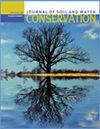Adoption of cover crops in Pennsylvania’s Chesapeake Bay watershed
IF 2.2
4区 农林科学
Q2 ECOLOGY
引用次数: 0
Abstract
Cover cropping is considered a very cost-effective practice to reduce losses of nitrogen (N) from cropland to surface waters, as well as mobile nutrients in the soil profile prone to being lost to ground water sources. Cover crops are an important component of states’ commitment to improve water quality in the Chesapeake Bay. Since 2016, annual cover crop transect surveys have been performed in Pennsylvania’s Chesapeake Bay watershed. The surveys show that cover crops were used on 39% of the annual crop area in the period 2016 to 2021, much higher than average cover crop use in the United States (5%). About two-thirds of the cover crop area is “commodity cover crops” that are harvested (which included both grain and forage harvesting in the surveys), while the other one-third is “traditional cover crops” that are not harvested. It appears that high cover crop adoption in Pennsylvania without generous subsidy payments is due in great part to their use for forage. However, at the moment, commodity cover crops receive no credit for pollutant reduction in the Chesapeake Bay Model if fall nutrients are applied, which means approximately two-thirds of cover crop implementation in Pennsylvania does not count toward nutrient pollution reduction to the Chesapeake Bay. Further, transect surveys are not considered a valid (or only partial) method of practice implementation and the present results are therefore not included when determining if states meet Total Maximum Daily Load (TMDL) limits. Considering their importance, the contribution of commodity cover crops to nutrient and sediment loss reduction from cropland needs to be better understood. Specifically, our study revealed the need to (1) clarify in Chesapeake Bay Model documentation that commodity cover crops include those harvested for forage besides those harvested for grain; (2) develop a tracking mechanism so that nutrient reduction credit from commodity cover crops can be recognized in the Chesapeake Bay Model; and (3) to review whether the lower N reduction credit from commodity cover crops than for traditional cover crops and lower credit for early planting are justified.宾夕法尼亚州切萨皮克湾流域采用覆盖作物
覆盖种植被认为是一种非常具有成本效益的做法,可以减少从农田到地表水的氮(N)损失,以及土壤剖面中易于流失到地下水中的流动养分。覆盖作物是各州承诺改善切萨皮克湾水质的重要组成部分。自2016年以来,在宾夕法尼亚州切萨皮克湾流域进行了年度覆盖作物样带调查。调查显示,2016年至2021年期间,覆盖作物的使用面积占年作物面积的39%,远高于美国覆盖作物的平均使用面积(5%)。大约三分之二的覆盖作物面积是收获的“商品覆盖作物”(调查中包括谷物和饲料的收获),而另外三分之一是没有收获的“传统覆盖作物”。在宾夕法尼亚州,没有慷慨补贴的高覆盖作物的采用在很大程度上是由于它们用于饲料。然而,目前,在切萨皮克湾模型中,如果使用秋季养分,商品覆盖作物没有获得污染物减少的信用,这意味着宾夕法尼亚州大约三分之二的覆盖作物的实施不计入切萨皮克湾的养分污染减少。此外,样带调查不被认为是一种有效的(或只是部分的)实践实施方法,因此,在确定各州是否满足总最大每日负荷(TMDL)限制时,不包括目前的结果。考虑到它们的重要性,需要更好地了解商品覆盖作物对减少农田养分和沉积物损失的贡献。具体而言,我们的研究表明需要(1)在切萨皮克湾模型文件中澄清,商品覆盖作物包括收获的饲料作物,而不是收获的谷物作物;(2)建立跟踪机制,使商品覆盖作物的营养减少信用可以在切萨皮克湾模型中得到认可;(3)审查商品覆盖作物的氮素减量抵免额低于传统覆盖作物和早期种植抵免额是否合理。
本文章由计算机程序翻译,如有差异,请以英文原文为准。
求助全文
约1分钟内获得全文
求助全文
来源期刊
CiteScore
4.10
自引率
2.60%
发文量
0
审稿时长
3.3 months
期刊介绍:
The Journal of Soil and Water Conservation (JSWC) is a multidisciplinary journal of natural resource conservation research, practice, policy, and perspectives. The journal has two sections: the A Section containing various departments and features, and the Research Section containing peer-reviewed research papers.

 求助内容:
求助内容: 应助结果提醒方式:
应助结果提醒方式:


